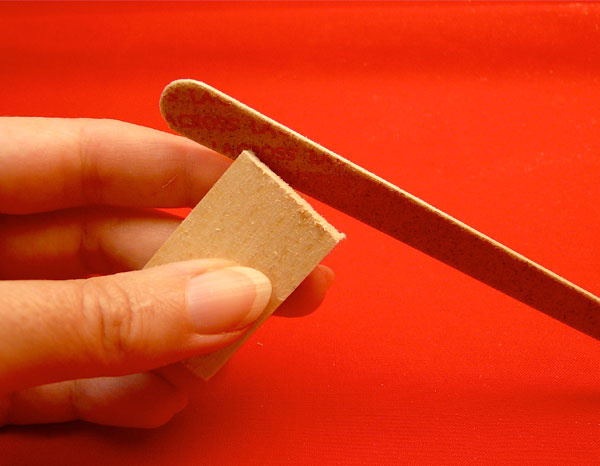Wooden Jewels for the Novice
Make intricate wood-inlay jewelry with the simplest of skills.
By Diane Gilleland
You don’t need any woodworking skills to make this fancy-looking wooden jewelry. The secret is inlay strips, which are sold pre-made as decorative elements for fine woodworking projects. They’re beautiful and easy to cut, and have lots of craft applications.
Here, with just a little glue and varnish, we’ll make an inlay pendant, earrings, and zipper pull.
 |
 |
 |
MATERIALS
Inlay strips of wood veneer (2) Try inlays.com, where short scraps 3"–5" long are inexpensive in bundles of 50.
Basswood:
3/16"×1" sheet, 1 ⅝" long
⅛"×½" stick, 1¼" long
Sold in 24" lengths at misterart.com.
Craft glue such as Aleene’s or Elmer’s
Table vise
Small coping saw
Fine-grit sandpaper or emery board
Metal straightedge
Mechanical pencil
Utility knife
Black acrylic paint (optional)
Water-based satin varnish
Small paintbrush
Jewelry findings:
Small screw eye, 8mm jump ring, chain or neck wire for the pendant
Small screw eye, 5mm jump ring for the zipper pull
Fold-over bail, 5mm jump ring, earring finding for the earring
I buy findings at firemountaingems.com.
Safety pin
Needlenose pliers
E-6000 adhesive eclecticproducts.com
1. Cut and sand the basswood.
Place a length of basswood in a table vise to hold it steady. Use a coping saw to cut a base piece for the pendant or zipper pull. (You won’t need any basswood for the earrings.) For the pendant, I cut a 1⅝" length of 3/16"×1" basswood sheet. For the zipper pull, I cut a 1¼" length of ⅛"×½" basswood stick.
Sand any rough edges. If you don’t have sandpaper, an emery board works well.
2. Cut the inlay strips.
I used 2 inlay strips here: inlay A, ½" wide; and inlay B, ¼" wide. Cut as many pieces as you need: for the pendant, I cut 2 lengths of inlay A and 6 of inlay B; for the zipper pull, I cut 2 lengths each of A and B; and for the earrings, I cut two 1⅛" lengths of inlay B, as shown below.
Measure your inlay strip so that it covers the length of the basswood, and draw a line across the strip. This material is easy to cut with a utility knife. Using a metal straightedge as a guide, draw the knife blade lightly over the inlay several times.
This creates a deep score, which you can use to cleanly break the material.
3. Glue the pieces together.
Apply a thin layer of glue to one side of the basswood and press the inlay pieces into the glue. When this side is completely covered with inlay, put the whole thing in the vise. Tighten the vise gently until you see glue begin to ooze out between the pieces.
Remove the piece from the vise and wipe away any excess glue. Allow the glue to dry for 5-10 minutes before proceeding to the next side.
Repeat this process to glue inlay to the other 3 sides of the basswood (you won’t bother with the top and bottom). Place the finished piece back in the vise to dry completely.
4. Paint (optional) and varnish.
For a more finished look (optional), paint black any remaining exposed areas of basswood, and allow it to dry. This looked nice with my inlays because of their dark edges. To protect the inlay, brush on 2 coats of satin varnish, allowing it to dry completely between coats.
5. Add jewelry findings.
To make the pendant, add a screw eye finding to the top of the pendant.
Then add an 8mm jump ring and a chain or neck wire.
NOTE: To add a screw eye, poke a small hole in the wood with a safety pin and then twist the screw eye into place.
To make a zipper pull, add a screw eye to the top of the pull, then add a 5mm jump ring, and attach it to a zipper.
To make earrings, use E-6000 adhesive to attach a fold-over bail to the inlay strip.
Add a 5mm jump ring, and attach an earring finding.
About the Author:
Diane Gilleland produces CraftyPod, a blog and podcast about making stuff.
10 thoughts on “How-To: Wood-Inlay Jewelry”
Comments are closed.
ADVERTISEMENT
Join Make: Community Today


























These look amazing but I’m having no luck finding inlay strips. The site suggested for 24″ strips doesn’t have any results for inlay or veneer that are useful and every place I’ve asked denies all knowledge.
I’m envisioning you crafting these up in a fully-loaded wordorking studio and cackling evilly at the thought of sending people off to search for stuff that doesn’t really exist. Given how awesome these are, I totally wouldn’t put it past you.
Tatiana, I found a wide variety of inlay strips for sale on this page of the Inlays.com website: http://inlays.com/wood_inlay_strips.asp . If your city has a Rockler store, they’ll have it too.
Nice!
now how about printer-friendly pages guys…
Very nice. I googled wood veneer inlays and found a number of options.
Hi,
I am trying to get into wooden jewlery making, I have yet located a source for the fittings or findings.
Can you suggest one.
thanks in advance
Dave